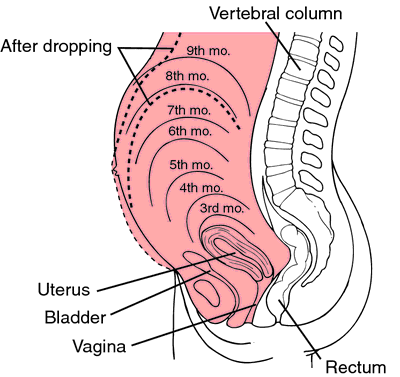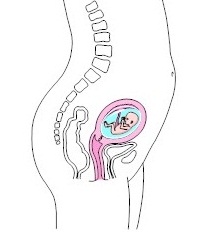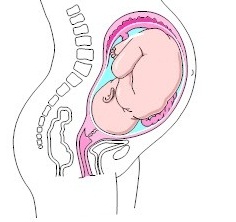 The uterus is one of the most vital organs in the female reproductive system. Implantation of the fertilized egg and development of the fetus all occur inside the uterus, making it a vital organ. Since the uterus holds the fetus as it develops into a baby, it’s natural that it should enlarge as the pregnancy progresses. During the entire pregnancy period, the uterus grows in size immensely and today we’ll look at the developments of uterus size during pregnancy.
The uterus is one of the most vital organs in the female reproductive system. Implantation of the fertilized egg and development of the fetus all occur inside the uterus, making it a vital organ. Since the uterus holds the fetus as it develops into a baby, it’s natural that it should enlarge as the pregnancy progresses. During the entire pregnancy period, the uterus grows in size immensely and today we’ll look at the developments of uterus size during pregnancy.
Uterus Size During Pregnancy
One of the major concerns expectant mums have while pregnant regards the changes occurring in their bodies, particularly the tummy. A lot of women are unsure about the size of their baby and the uterus as well. The uterus which is located deep inside the pelvis will without a doubt enlarge from its normal small size and this experience is likened to blowing up a balloon. Let’s have a look at the changes to expect.
|
Stage of Pregnancy |
Changes of Uterus Size During Pregnancy |
|
First trimester
|
In the first trimester, the uterus remains small and is the size of a grape. As the pregnancy progresses, the baby will start to develop outside the pelvis, but still be small enough to fit in the pelvic area. When carrying multiple pregnancies such as twins or triplets, development will occur sooner and stretching will be faster as well. The uterus can be felt when your belly is touched. |
|
Second trimester
|
In the second trimester, your uterus will enlarge to the size of a papaya. This means that it can no longer fit in the pelvis. In this stage, the uterus moves between the navel and breasts and starts to push other organs away from their normal location. This causes tension within other surrounding muscles bringing about symptoms body aches and pains. However, this is all normal and the uterus pressure may even pop out your navel. |
|
Third trimester
|
In the third trimester, your uterus should be as big as a watermelon. At full term, the uterus will be quite large extending from your pubic area all the way to the lower part of your rib cage. As you approach child birth, your baby will drop into the pelvis. |
How to Measure Your Uterus During Pregnancy
There are a few ways to find out how large your uterus is during pregnancy. Here’s how:
- Step 1: Lay down flat on your back on the floor or on your bed. Make sure that you are comfortable.
- Step 2: Proceed to touch your tummy so as to feel your uterus. In a pregnancy of 20 weeks, the uterus should be felt just below the navel and if you are over 20 weeks pregnant, the uterus should be above the navel. Your uterus will feel round, smooth and slightly hard. You can move your hand around to feel the top of the uterus which is also referred to as the fundus. Usually the uterus should be felt after 20 weeks because the measurements are not reliable before that.
- Step 3: Your pubic bone is located right above you pubic hair line. The bone tip you feel on top is the pubic bone.
- Step 4: Measure the distance between the fundus and the pubic bone. The number you get should be the same as the number of weeks you are pregnant. For example, if you are 30 weeks pregnant, the measurement would be about 30 centimeters. Depending on how far along your pregnancy is; the numbers may be less or more. If the measurements are far apart from your number of weeks, you might want to discuss this with your doctor.
Congratulations! You can now measure the size of your uterus.
Other Uterus Changes During Pregnancy
1. Changes of Lower Segment During Pregnancy
A lot of changes occur during pregnancy. As mentioned, the uterus develops outside the pelvis as the baby develops. You should be able to feel your fundus at just 12 weeks pregnant and by the time you reach 24 weeks, your myometrium muscles should begin to stretch upwards. This makes the upper part of your uterus thicker, leaving thinner muscle layers referred to as the lower segment below. This lower segment is what separates the cervix and the upper segment. The lower segment’s role is to absorb the dilated cervix during labor.
Lower segment muscles form around a third of the uterus lower part and this weak muscle layer often has less supply of blood when compared to the upper part. This is why caesarean operations are not conducted on the upper segment. Usually, the cut is done on the lower segment just above the pubic hairline where there is less blood flow to prevent excessive bleeding.
2. Changes of Ligaments During Pregnancy
Normally, the uterus leans toward the right side as the pregnancy progresses to its last stages. During this stage, the uterus is held by the ligaments which also stretch as the baby develops. The ligaments act as anchors, supporting and stabilizing the uterus while facilitating movements inside the uterus.
Belly aches and temporary sharp pains within the groin are all quite common during pregnancy. This is caused by strains within the ligament and is known as ligament pain. These sharp pains often occur with sudden movements, such as sneezing or coughing.




